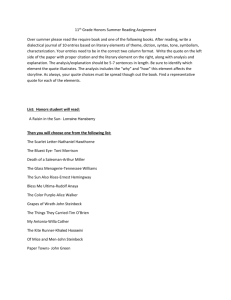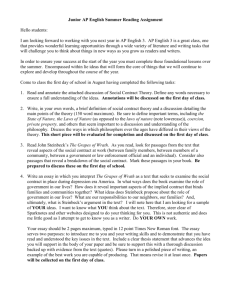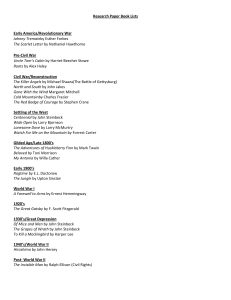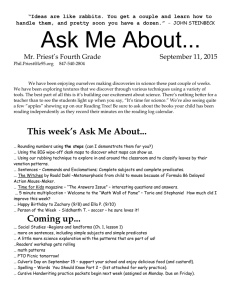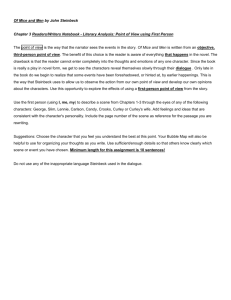AP LITERATURE – ANNOTATIONS & READER RESPONSE JOURNAL (AKA PROOF... Annotations AND
advertisement
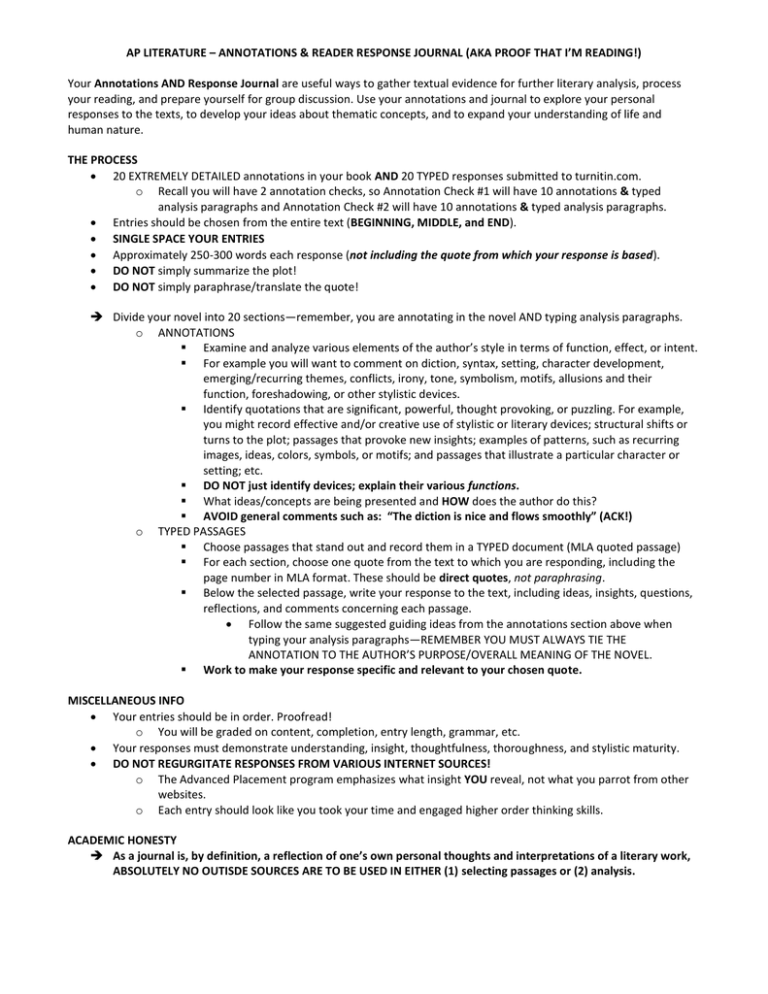
AP LITERATURE – ANNOTATIONS & READER RESPONSE JOURNAL (AKA PROOF THAT I’M READING!) Your Annotations AND Response Journal are useful ways to gather textual evidence for further literary analysis, process your reading, and prepare yourself for group discussion. Use your annotations and journal to explore your personal responses to the texts, to develop your ideas about thematic concepts, and to expand your understanding of life and human nature. THE PROCESS 20 EXTREMELY DETAILED annotations in your book AND 20 TYPED responses submitted to turnitin.com. o Recall you will have 2 annotation checks, so Annotation Check #1 will have 10 annotations & typed analysis paragraphs and Annotation Check #2 will have 10 annotations & typed analysis paragraphs. Entries should be chosen from the entire text (BEGINNING, MIDDLE, and END). SINGLE SPACE YOUR ENTRIES Approximately 250-300 words each response (not including the quote from which your response is based). DO NOT simply summarize the plot! DO NOT simply paraphrase/translate the quote! Divide your novel into 20 sections—remember, you are annotating in the novel AND typing analysis paragraphs. o ANNOTATIONS Examine and analyze various elements of the author’s style in terms of function, effect, or intent. For example you will want to comment on diction, syntax, setting, character development, emerging/recurring themes, conflicts, irony, tone, symbolism, motifs, allusions and their function, foreshadowing, or other stylistic devices. Identify quotations that are significant, powerful, thought provoking, or puzzling. For example, you might record effective and/or creative use of stylistic or literary devices; structural shifts or turns to the plot; passages that provoke new insights; examples of patterns, such as recurring images, ideas, colors, symbols, or motifs; and passages that illustrate a particular character or setting; etc. DO NOT just identify devices; explain their various functions. What ideas/concepts are being presented and HOW does the author do this? AVOID general comments such as: “The diction is nice and flows smoothly” (ACK!) o TYPED PASSAGES Choose passages that stand out and record them in a TYPED document (MLA quoted passage) For each section, choose one quote from the text to which you are responding, including the page number in MLA format. These should be direct quotes, not paraphrasing. Below the selected passage, write your response to the text, including ideas, insights, questions, reflections, and comments concerning each passage. Follow the same suggested guiding ideas from the annotations section above when typing your analysis paragraphs—REMEMBER YOU MUST ALWAYS TIE THE ANNOTATION TO THE AUTHOR’S PURPOSE/OVERALL MEANING OF THE NOVEL. Work to make your response specific and relevant to your chosen quote. MISCELLANEOUS INFO Your entries should be in order. Proofread! o You will be graded on content, completion, entry length, grammar, etc. Your responses must demonstrate understanding, insight, thoughtfulness, thoroughness, and stylistic maturity. DO NOT REGURGITATE RESPONSES FROM VARIOUS INTERNET SOURCES! o The Advanced Placement program emphasizes what insight YOU reveal, not what you parrot from other websites. o Each entry should look like you took your time and engaged higher order thinking skills. ACADEMIC HONESTY As a journal is, by definition, a reflection of one’s own personal thoughts and interpretations of a literary work, ABSOLUTELY NO OUTISDE SOURCES ARE TO BE USED IN EITHER (1) selecting passages or (2) analysis. SAMPLE JOURNAL RESPONSES 20 TYPED Responses – Annotation Check #1 = 10 entries; Annotation Check #2 = 10 entries. Choose passages that stand out and record them in a TYPED document (MLA quoted passage) – SAMPLES BELOW Entries should be chosen from the entire text (BEGINNING, MIDDLE, and END). SINGLE SPACE YOUR ENTRIES Approximately 250-300 words each response (not including the quote from which your response is based). o You MUST include a WORD COUNT DO NOT simply summarize the plot! DO NOT simply paraphrase/translate the quote! Entry # (The Lord of the Flies by William Golding) “Piggy moved among the crowd, asking names frowning to remember them” (Golding 15). The concept of names/naming is a motif, as Piggy demonstrates a preoccupation with names numerous times. He systematically goes about asking Ralph and the smaller children their names. Names seem to be a symbol for both ordered society and individual identity. Though Ralph does not put the same emphasis on names that Piggy does, Piggy’s own concern with them is an example of his concern with order. The significance he finds in names as a representation of one’s identity and as a tool of communication spurs his hatred of his own nickname. (word count = 92). THIS IS TOO SHORT! Entry # (The Lord of the Flies by William Golding) “Jack’s arms came down: the heaving circle cheered and made pig-dying noises. Then they lay quiet, panting, listening to Robert’s frightened snivels . . . ‘You want a real pig,’ said Robert, still caressing his rump, ‘because you’ve got to kill him.’ ‘Use a littlun,’ said Jack, and everybody laughed” (Golding 130). Golding continues to further demonstrate how the boys have begun the process of dehumanization, of trivializing the value of human lives. Robert, playing the part of the pig in a “dance” demonstrates both that the boys are becoming savage animals themselves and also that the lives of others are starting to become as unimportant as those of animals. No longer retaining a sense of the sanctity of life, Jack is easily able to kill a pig, approaching the point at which he could also kill a human. The pig itself becomes a symbol for the boys’ own savage desire and the loss of their inhibitions. Also, the passage foreshadows Jack’s, and soon his hunters’, shift in attitude towards killing because he moves from the killing of an animal for food to his ruthless killing of other boys who oppose him. (word count = 150). STILL TOO SHORT, BUT BETTER. Entry # (The Things They Carried by Tim O’Brien) “they carried like freight trains; they carried it on their backs and shoulders – and for all the ambiguities of Vietnam, all the mysteries and the unknowns, there was at least the single abiding certainty that they would never be at a loss for things to carry” (O’Brien 2). O’Brien chooses to end the first section of the novel with this sentence. He provokes excellent visual details of what each soldier in Vietnam would carry for day-to-day fighting. He evokes the feeling of the physical weight of what soldiers have to carry for simple survival. Combining the emotional weight of loved ones at home, the fear of death, and the responsibility for the men with whom they fight, it can be moderately glimpsed what soldiers dealt with every single day of their military lives. This quotation sums up the confusion that the men felt about the reasons they were fighting the war, and how they clung to the only certainty—things they had to carry—in a confusing world where normal rules were suspended. To the average individual, whether in high school or working as a professional throughout the work force, this is a foreign situation that we hope to never experience. However, it is only through experiencing that which is foreign that we eventually begin to gain insightful knowledge beyond our own limited vision. While only a brief passage selection, Tim O’Brien conveys the complexity of a wartime experience. (word count = 192) GETTING THERE. Entry # (Of Mice and Men by John Steinbeck) The author reflects the theme of nature and animals when he narrates that the “Rabbits came out of the brush to sit on the sand” (Steinbeck 1). Steinbeck further creates imagery in regards to the theme of nature and animals when he states “On the sand banks the rabbits sat as quietly as little gray, sculptured stones” (2). Steinbeck appeals to the reader’s senses in this quote, specifically touch/feel, sight, and sound. He first appeals to the sense of feel/touch by describing the “sand bank” setting. This example is an appeal to touch because the reader can imagine the sand and its texture. The author then creates sight imagery by describing the different objects within the setting, such as the rabbit; he further emphasizes their stillness with their comparison to a stone. Finally, Steinbeck describes the rabbits as sitting “quietly” to emphasize a lack of noise, which reflects the idea of a calm atmosphere. The effect on the mood of the story is that Steinbeck creates visuals in the reader’s mind that are warm, peaceful, and calm. The sensory details related to nature within Steinbeck’s description also create a sense of calm for the beginning of the chapter. Steinbeck additionally describes a sense of safety when he narrates that the rabbits came out of the brush to sit on the sand. The animal imagery, in this example, rabbits, suggests that the area by the Salinas River is a safe place. Rabbits, which are extremely cautious and easily frightened, feel at ease enough to sit on the sand and appear to the reader as unafraid. Their lack of fear suggests to the reader that the area by the Salinas River is not only safe, but also a haven, or sanctuary for all living beings. This area becomes all the more meaningful, then, when George tells Lennie that Lennie is to return to the area if Lennie ever got into trouble. The reader realizes that the area by the Salinas River has become George and Lennie’s unofficial “safe” place—their haven/sanctuary for when they encounter trouble from which they need to escape. (Word Count = 292) GOOD STUFF! Range can = +/- 10 words.
